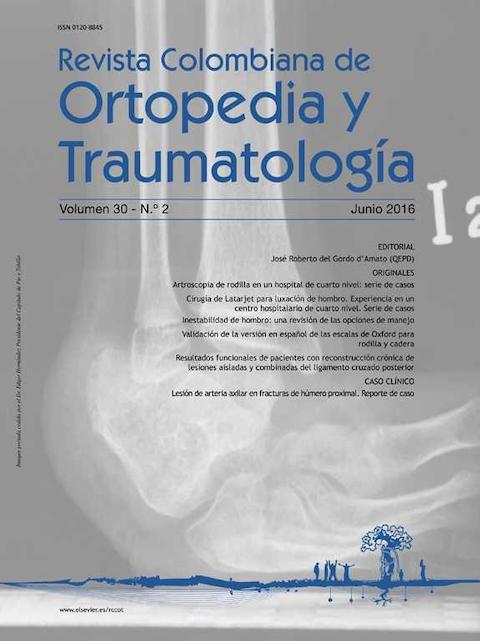Resultados funcionales de pacientes con reconstrucción crónica de lesiones aisladas y combinadas del ligamento cruzado posterior
DOI:
https://doi.org/10.1016/j.rccot.2016.07.006Palabras clave:
ligamento cruzado posterior, lesiones aisladas, lesiones combinadas, reconstrucción crónicaResumen
Introducción: Los procedimientos quirúrgicos para la reconstrucción del ligamento cruzado posterior (LCP) aislados y combinados han demostrado resultados modestos que requieren más investigación. El objetivo del estudio fue evaluar los resultados funcionales del tratamiento quirúrgico de las lesiones crónicas aisladas y combinadas del LCP.
Materiales y métodos: Se realizó un estudio de cohorte retrospectivo en pacientes con lesiones aisladas y combinadas del LCP con inestabilidad de grado III, tratados mediante reconstrucción ligamentaria por un mismo cirujano en un acto operatorio en que se habían utilizado diversas técnicas. Los resultados se evaluaron mediante las escalas funcionales de Lysholm y Tegner, y valoración clínica postoperatoria. El seguimiento promedio fue 66,30 ± 48,06 meses (rango: 12,4-158,6).
Resultados: La cohorte general de pacientes estaba compuesta por 29 pacientes (27 hombres y 2 mujeres), militares activos, y un total de 30 rodillas: 17 con lesión aislada del LCP y 13 combinadas (LCP + LCA: 3, LCP + EPL: 5, LCP + LCA + EPL: 5). El tiempo medio entre la lesión y la reconstrucción quirúrgica fue 17 meses (rango: 4-36 meses). La funcionalidad con la escala de Lysholm entre excelente y buena alcanzó el 83,4%. En la escala de Tegner alcanzó el 86,7% con capacidad para practicar actividad física recreativa y/o de competición. No se encontraron diferencias significativas con LCP y LCP combinada en Lysholm (p = 0,562) y en Tegner (p = 0,202), ajustadas por las variables de confusión. El examen físico postoperatorio reveló cajón posterior y step off tibial normal en 15 rodillas (50%); la estabilidad posterolateral fue normal en 4 rodillas (66%).
Discusión: Existen controversias en el tratamiento quirúrgico de estas lesiones. La evidencia no se inclina por una técnica quirúrgica en particular. En el presente estudio se utilizaron diferentes técnicas quirúrgicas y se obtuvieron buenos resultados funcionales si se considera que son el producto de una técnica depurada, que el sistema de fijación es híbrido, así como la rehabilitación posoperatoria. La reconstrucción crónica ofrece grandes beneficios funcionales.
Nivel de evidencia clínica: Nivel IV.
Descargas
Referencias bibliográficas
Matava MJ, Ellis E, Gruber B. Surgical treatment of posterior cruciate ligament tears: an evolving technique. J Am Acad Orthop Surg. 2009;17:435-46. https://doi.org/10.5435/00124635-200907000-00004
Stannard JP, McKean RM. Anatomic PCL reconstruction: The double bundle inlay technique. Oper Tech Sport Med. 2009;17:148-55. https://doi.org/10.1053/j.otsm.2009.06.005
Shelbourne KD, Davis TJ, Patel DV. The natural history of acute, isolated, nonoperatively treated posterior cruciate ligament injuries. A prospective study. Am J Sports Med. 1999;27: 276-83. https://doi.org/10.1177/03635465990270030201
Shelbourne KD, Muthukaruppan Y. Subjective results of nonoperatively treated, acute, isolated posterior cruciate ligament injuries. Arthroscopy. 2005;21:457-61. https://doi.org/10.1016/j.arthro.2004.11.013
Bergfeld JA, McAllister DR, Parker RD, Valdevit AD, Kambic HE. A biomechanical comparison of posterior cruciate ligament reconstruction techniques. Am J Sports Med. 2001;29:129-36. https://doi.org/10.1177/03635465010290020401
Markolf KL, Zemanovic JR, McAllister DR. Cyclic loading of posterior cruciate ligament replacements fixed with tibial tunnel and tibial inlay methods. J Bone Joint Surg Am. 2002;84- A:518-24. https://doi.org/10.2106/00004623-200204000-00002
Berg EE. Posterior cruciate ligament tibial inlay reconstruction. Arthroscopy. 1995;11:69-76. https://doi.org/10.1016/0749-8063(95)90091-8
Sung-Jae K, Chong-Hyuk C, Hyoung-Sik K. Arthroscopic posterior cruciate ligament tibial inlay reconstruction. Arthroscopy. 2006;20:149-54. https://doi.org/10.1016/j.arthro.2004.04.023
Campbell RB, Jordan SS, Sekiya JK. Arthroscopic tibial inlay for posterior cruciate ligament reconstruction. Arthroscopy. 2007;23:1-4. https://doi.org/10.1016/j.arthro.2007.01.020
Niedzwietzki P, Zantop T, Weimann A, Herbort M, Raschke MJ, Petersen W. Femoral fixation of hamstring grafts in posterior cruciate ligament reconstruction: biomechanical evaluation of different fixation techniques: is there an acute angle effect. Am J Sport Med. 2007;35:780-6. https://doi.org/10.1177/0363546506297906
Margheritini F, Rihn J, Mauro CS, Stabile KJ, Woo SL-Y, Harner CD. Biomechanics of initial tibial fixation in posterior cruciate ligament reconstruction. Arthroscopy. 2013;21:1164-71. https://doi.org/10.1016/j.arthro.2005.06.017
Lysholm J, Gillquist J. Evaluation of knee ligament surgery results with special emphasis on use of a scoring scale. Am J Sport Med. 1982;10:150-4. https://doi.org/10.1177/036354658201000306
Yelverton Tegner JL. Rating systems in the evaluation of knee ligament injuries original tegner.pdf. 1984. p. 43.
Fanelli GC, Giannotti BF, Edson CJ. The posterior cruciate ligament arthroscopic evaluation and treatment. Arthroscopy. 1994;10:673. https://doi.org/10.1016/S0749-8063(05)80067-2
De los Ríos A. Luxación de rodilla. Tratamiento quirúrgico en casos agudos. Rev Col Or Tra. 2005;19:34.
Johnson D. Sports medicine posterior cruciate ligament: a literature review. Curr Orthop Pract. 2010;21:27-31. https://doi.org/10.1097/BCO.0b013e3181c7595c
Larsson RV. Isometry of the lateral collateral and popliteofibular ligaments and techniques for reconstruction using a free semitendinosus tendon graft. Oper Tech Sport Med. 2001;9:84. https://doi.org/10.1053/otsm.2001.21765
Levy B, Stuart MJ, Whelan DB. Posterolateral instability of the knee: evaluation, treatment, results. Sports Med Arthrosc. 2010;18:254-62. https://doi.org/10.1097/JSA.0b013e3181f88527
Fanelli GC EC. Combined posterior cruciate ligament posterolateral reconstructions with Achilles tendon allograft and biceps femoris tendon tenodesis: 2- to 10-year follow-up. Arthroscopy. 2004;4:339. https://doi.org/10.1016/j.arthro.2004.01.034
Lara G. Tratamiento de la inestabilidad rotatoria crónica posteroexterna de la rodilla con aloinjerto de tendón de aquiles. Rev Col Or Tra. 2005;19:43.
Noyes FR, Medvecky MJ. Arthroscopically assisted quadriceps doublé-bundle tibial inlay posterior cruciate ligament reconstruction: an analysis of techniques and a safe operative approach to the popliteal fossa. Arthroscopy. 2003;19:894. https://doi.org/10.1016/S0749-8063(03)00651-0
Markolf KL, Feeley BT, Tejwani SG, Martin DE. Changes in knee laxity and ligament force after sectioning the posteromedial bundle of the posterior cruciate ligament. Arthroscopy. 2006;22:1100. https://doi.org/10.1016/j.arthro.2006.05.018
Kohen RB, Sekiya JK. Single-bundle versus double-bundle posterior cruciate ligament reconstruction. Arthroscopy. 2009;25:1470-7. https://doi.org/10.1016/j.arthro.2008.11.006
Morales F, De los Ríos A. Rehabilitación en lesiones del ligamento cruzado posterior. Rev Col Or Tra. 2006;20:31.
Panchal HB, Sekiya JK. Open tibial inlay versus arthroscopic transtibial posterior cruciate ligament reconstructions. Arthroscopy. 2011;27:1289-95. https://doi.org/10.1016/j.arthro.2011.04.007
Papalia R, Osti L, Del Buono A, Denaro V, Maffulli N. Tibial inlay for posterior cruciate ligament reconstruction: a systematic review. Knee. 2010;17:264-9. https://doi.org/10.1016/j.knee.2010.02.006
Levy BA, Dajani KA, Whelan DB, Stannard JP, Fanelli GC, Stuart MJ, et al. Decision making in the multiligament-injured knee: An evidence-based systematic review. Arthroscopy. 2009;25:430-8. https://doi.org/10.1016/j.arthro.2009.01.008
Descargas
Publicado
Cómo citar
Número
Sección
Licencia
Derechos de autor 2024 Revista Colombiana de ortopedia y traumatología

Esta obra está bajo una licencia Creative Commons Reconocimiento 3.0 Unported.








